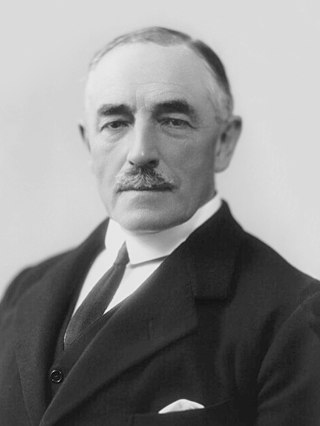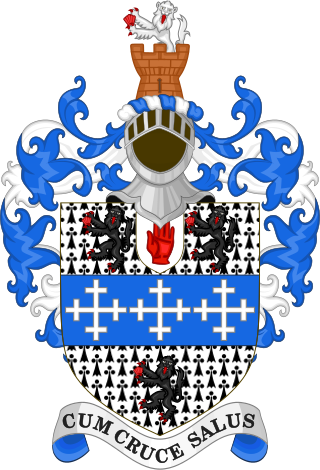
Earl Ferrers is a title in the Peerage of Great Britain. It was created in 1711 for Robert Shirley, 14th Baron Ferrers of Chartley. The Shirley family descends from George Shirley of Astwell Castle, Northamptonshire. In 1611 he was created a Baronet, of Staunton Harold in the County of Leicester, in the Baronetage of England. He was succeeded by his son Henry, the second Baronet, who married Lady Dorothy Devereux, daughter of Robert Devereux, 2nd Earl of Essex. On the death of her brother Robert Devereux, 3rd Earl of Essex, she became the youngest co-heir to the baronies of Ferrers of Chartley and the barony of Bourchier, which had fallen into abeyance on the death of the third Earl. Shirley was succeeded by his eldest son, the third Baronet. He died unmarried and was succeeded by his younger brother, the fourth Baronet. He was imprisoned in the Tower of London by Oliver Cromwell and died there in 1656. On his death the title passed to his eldest son, the fifth Baronet. He died at an early age and was succeeded at birth by his posthumous son, the sixth Baronet.

Earl of Stradbroke, in the County of Suffolk, is a title in the Peerage of the United Kingdom. It was created in 1821 for John Rous, 1st Baron Rous, who had earlier represented Suffolk in the House of Commons.

Earl of Cottenham, of Cottenham in the County of Cambridge, is a title in the Peerage of the United Kingdom. It was created in 1850 for the prominent lawyer and Whig politician Charles Pepys, 1st Baron Cottenham. ) He served as Lord Chancellor from 1836 to 1841 and from 1846 to 1850. Pepys had already been created Baron Cottenham, of Cottenham in the County of Cambridge, in 1836, and was made Viscount Crowhurst, of Crowhurst in the County of Surrey, at the same time he was given the earldom. These titles are also in the Peerage of the United Kingdom. The viscountcy is used as a courtesy title for the Earl's eldest son and heir apparent.

Earl St Aldwyn, of Coln St Aldwyn in the County of Gloucester, is a title in the Peerage of the United Kingdom. It was created in 1915 for the prominent Conservative politician Michael Hicks Beach, 1st Viscount St Aldwyn, known from 1854 to 1907 as Sir Michael Hicks Beach, 9th Baronet, of Beverston. He was Chancellor of the Exchequer from 1885 to 1886 and again from 1895 to 1902. Hicks Beach had already been created Viscount St Aldwyn, of Coln St Aldwyn in the County of Gloucester, in 1906, and was made Viscount Quenington, of Quenington in the County of Gloucester, at the same time he was given the earldom. Both titles are in the Peerage of the United Kingdom. He was succeeded by his grandson, the second Earl, the son of Michael Hicks Beach, Viscount Quenington, Member of Parliament for Tewkesbury, who was killed in action in 1916. Lord St Aldwyn was also a Conservative politician and was Captain of the Honourable Corps of Gentlemen-at-Arms between 1958 and 1964 and 1970 and 1974. As of 2018 the titles are held by his eldest son, the third Earl, who succeeded in 1992.

Baron Muskerry is a title in the Peerage of Ireland. It was created in 1781 for Sir Robert Deane, 6th Baronet. He had previously represented County Cork in the Irish House of Commons.
Baron Kennet, of the Dene in the County of Wiltshire, is a title in the Peerage of the United Kingdom. It was created in 1935 for the journalist and politician Sir Hilton Young. He was the youngest son of Sir George Young, 3rd Baronet, of Formosa Place. He was succeeded by his son, the second Baron. He was a writer and politician. As of 2010, the title is held by his son, the third Baron, who succeeded in 2009. As a great-grandson of Sir George Young, 3rd Baronet, of Formosa Place, he is also in remainder to this title.

Baron Milford is a title that has been created three times, once in the Peerage of Ireland and twice in the Peerage of the United Kingdom. All three creations have been for members of the same family. The first creation came in the Peerage of Ireland in 1776 when Sir Richard Philipps, 7th Baronet, of Picton Castle was made Baron Milford. However, this title became extinct on his death in 1823, while the baronetcy was passed on to a distant relative. The title was revived in the Peerage of the United Kingdom in 1847 when Sir Richard Philipps, 1st Baronet, of Picton Castle was created Baron Milford, of Picton Castle in the County of Pembroke. Born Richard Bulkeley Philipps Grant, he was the son of John Grant and Mary Philippa Artemisia, daughter of James Child and Mary Philippa Artemisia, daughter of Bulkeley Philipps, uncle of the first Baron of the first creation. He succeeded to the Philipps estates in 1823 and assumed the surname of Philipps the same year. In 1828 he was created a Baronet, of Picton Castle in the County of Pembroke, in the Baronetage of the United Kingdom. However, Lord Milford was childless and the titles became extinct on his death in 1857. He devised his estates to his half-brother Reverend James Henry Alexander Gwyther, who assumed the surname of Philipps. James's daughter Mary Philippa married Charles Edward Gregg Fisher, who assumed the surname of Philipps and was created a Baronet, of Picton, in 1887.

Baron Broadbridge, of Brighton in the County of Sussex, is a title in the Peerage of the United Kingdom. It was created in 1945 for the Conservative politician Sir George Broadbridge, 1st Baronet. He had already been created a Baronet, of Wargrave Place in the County of Berkshire, on 22 November 1937. The title descended from father to son until the death of his grandson, the third Baron, in 2000. The late Baron was succeeded by his first cousin, who became the fourth holder of the titles. He was the son of Hugh Trevor Broadbridge, third son of the first Baron. He was in turn succeeded by his only son, Richard, a retired air vice-marshal who was honorary surgeon to the Queen, in 2020.
Baron Crawshaw, of Crawshaw in the County Palatine of Lancaster and of Whatton in the County of Leicester is a title in the Peerage of the United Kingdom. It was created on 25 August 1892 for Sir Thomas Brooks, 1st Baronet. He notably served as High Sheriff of Lancashire in 1884. Brooks had already been created a baronet in the Baronetage of the United Kingdom, of Crawshaw Hall and Whatton House, on 9 February 1891. As of 2013 the titles are held by his great-grandson, the fifth Baron, who succeeded his elder brother in 1997.
Baron Rathcavan, of The Braid in the County of Antrim, is a title in the Peerage of the United Kingdom. It was created on 11 February 1953 for the Unionist politician Sir Hugh O'Neill, 1st Baronet. He had already been created a Baronet, of Cleggan in the County of Antrim, on 17 June 1929. O'Neill was the third son of Edward O'Neill, 2nd Baron O'Neill and the uncle of the Prime Minister of Northern Ireland Terence O'Neill, Baron O'Neill of the Maine. Lord Rathcavan was also a male-line descendant of Edward Chichester, 1st Viscount Chichester. He was succeeded by his eldest surviving son, the second Baron. He succeeded his father as Unionist Member of Parliament for Antrim in 1952, a seat he held until 1959, and was later a member of the Parliament of Northern Ireland. As of 2014 the titles are held by his son, the third Baron, who succeeded in 1994.

Sir John Edward Kynaston Studd, 1st Baronet, known as "JEK", was a British cricketer, businessman and Lord Mayor of London.
The Willink Baronetcy, of Dingle Bank in the City of Liverpool, is a title in the Baronetage of the United Kingdom. It was created on 20 July 1957 for the Conservative politician and public servant Henry Willink. He served as Minister of Health from 1943 to 1945. As of 2010 the title is held by his grandson, the third Baronet, who succeeded in 2009.

There have been three baronetcies created for members of the Blakiston family of Blakiston, County Durham, two in the Baronetage of England and one in the Baronetage of Great Britain. One creation is extant as of 2008.

There have been two baronetcies created for the Guise family, one in the Baronetage of England and one in the Baronetage of Great Britain. The latter creation is extant as of 2014.
The Buzzard Baronetcy, of Munstead Grange in the Parish of Godalming in the County of Surrey, is a title in the Baronetage of the United Kingdom. It was created on 25 June 1929 for the prominent physician Sir Farquhar Buzzard. He was Regius Professor of Medicine at the University of Oxford from 1928 to 1943 and Physician-in-Ordinary to King George V from 1932 to 1936. Buzzard was succeeded by his eldest son, the second Baronet. He was a Rear-Admiral in the Royal Navy. As of 2007 the title is held by his eldest son, the third Baronet, who succeeded in 1972.
There have been five baronetcies created for persons with the surname Ward, one in the Baronetage of England, one in the Baronetage of Ireland and three in the Baronetage of the United Kingdom. See also Warde baronets.
There have been three baronetcies created for persons with the surname Everard, one in the Baronetage of Ireland, one in the Baronetage of England and one in the Baronetage of the United Kingdom. Only one creation is extant as of 2010.

The Mountain Baronetcy, of Oare Manor in the County of Somerset and Brendon in the County of Devon, is a title in the Baronetage of the United Kingdom. It was created on 23 January 1922 for Edward Mountain. He was Chairman of Eagle Star & British Dominions Insurance Company Limited. The second Baronet succeeded Sir Edward as Chairman of Eagle Star Insurance Company Ltd. The third Baronet also became Chairman of Eagle Star Insurance Company Ltd.
There have been four baronetcies created for persons with the surname Musgrave, one in the Baronetage of England, one in the Baronetage of Nova Scotia, one in the Baronetage of Ireland and one in the Baronetage of the United Kingdom. As of 2014 two of the creations are extant.

The Sebright Baronetcy, of Besford in the County of Worcester, is a title in the Baronetage of England. It was created on 20 December 1626 for Edward Sebright, High Sheriff of Worcestershire who later fought as a Royalist in the Civil War. He was the son of John Sebright of Blakeshall, Wolverley and was the heir of his uncle William Sebright (1541–1620) of Besford, who established by his will in 1620 the charity "Sebright's Endowed Schools", still surviving today and very richly endowed as "Sebright's Educational Foundation". The fourth Baronet sat as Member of Parliament for Hertfordshire. The sixth Baronet represented Bath in the House of Commons. The seventh Baronet was Member of Parliament for Hertfordshire and also became known as an agriculturalist. The family's fortunes ebbed by the end of the nineteenth century, with the ninth Baronet leaving only £5 at his death. The current baronet is Sir Rufus Hugo Giles Sebright, born 1978 in Nîmes, France.









